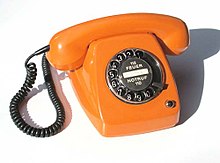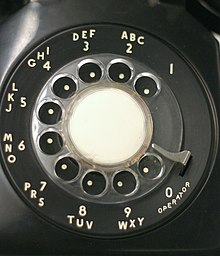Rotary dial

The rotary dial is a device mounted on or in a telephone or switchboard that is designed to send interrupted electrical pulses, known as pulse dialing, corresponding to the number dialed. The early form of the rotary dial used lugs on a finger plate instead of holes. A patent was filed on August 20, 1896 by employees of Almon Strowger, namely, A. E. Keith and the brothers John and Charles Erickson. The Patent No. 597,062 was granted on January 11, 1898.
The modern version of the rotary dial with holes was first introduced in 1904 but only entered service in the Bell System in 1919. The device was phased out from the 1970s onwards, though made until 2006, with the onset of Touch Tone dialing, which uses a telephone keypad instead of a dial. Some telephone systems in the US no longer recognize rotary dialing by default, but will only support push-button phones instead, in which case the rotary dialing system would have to be ordered from the telephone company as a special feature, to support older customer equipment. However most actually do accept dial phoning without fail.
In telephony, the word dialing describes the process of placing a telephone call, or more specifically of entering the number to be called into the telephone system.

History

From as early as 1836, there were various suggestions and inventions of dials for sending telegraph signals. After the first commercial telephone exchange was installed in 1878, the need for an automated, user-controlled method of directing a telephone call became apparent. The first telephone dial patent was jointly issued to Connolly and McTighe in 1879. There were numerous competing inventions, and 26 patents of dials, push-buttons, and similar mechanisms for signalling which telephone subscriber was wanted by a caller were issued prior to 1891. Most inventions involved highly complex, and expensive, mechanisms and required the user to perform complex manipulations.
The first commercial installation of a Telephone Dial accompanied the first commercial installation of a 99 line automatic telephone exchange in La Porte, Indiana in 1892, which was based on the 1891 Strowger patent designs. The original dial designs were rather cumbersome and development continued during the 1890s and early 1900s hand in hand with the switching technology. In the 1950s, invention of plastics saw the dial itself change from metal disk to a plastic ring.
In the early 1960s Bell Telephone Laboratories researched various key pad layouts to replace the telephone dial, for electronic telephone equipment. Researchers rearranged the dial numbers in a wide range of combinations from mimicking a telephone dial to the now familiar 4 row by 3 column keypad. They found the 4x3 keypad to be the fastest and most error free arrangement to operate. However, because the American telephone dial had the 0 next to the 9, they tested the arrangement with a 1 at the top and 0 at the bottom, below the 8 key. They also tested an arrangement with the 0 below the 2 and having 9 at the top, as appeared on adding machines at that time and now appears on computer and calculator keyboards, but that arrangement was more error prone as few people were familiar with adding machines at that time. Because of this research, phone key pad numbering is reversed when compared to today's calculator and computer keyboards. However, the keypads of most cash machines usually have the same numbering as phone key pads.
Even today, rotary phones occasionally find special uses. For instance, the anti-drug Fairlawn Coalition of the Anacostia section of Washington, DC, persuaded the phone company to install rotary dials on area pay phones. The goal was to discourage loitering by drug purchasers, since the dials could not be used to call dealers' pagers.[1]
Form

The dial is circular. In its most common form, the dial is about 3 inches (76.2 mm) in diameter. Ten finger holes are cut through its outer perimeter. The dial is mounted via a shaft extending from inside the telephone or mounting and sits approximately 6 mm (¼ inch) above a faceplate. The faceplate is set so that through each finger hole, letters and numbers printed on the faceplate may be seen. In North America, traditional dials have letter codes displayed with the numbers under the finger holes in the following pattern: 1, 2 ABC, 3 DEF, 4 GHI, 5 JKL, 6 MNO, 7 PRS, 8 TUV, 9 WXY, and 0 Operator. However, such letter codes were not used in all countries. Older Australian rotary dial telephones also had letters, but the combinations were often printed in the center plate adjacent to the number. The 1 is normally set at approximately 60 degrees clockwise from the uppermost point of the dial, or approximately at the 2 o'clock position on a clock face, and then the numbers progress upward counterclockwise, with the 0 being at about 5 o'clock. A curved device called a finger stop sits above the dial at the 4 o'clock position.
The dial numbering can occur in 4 different formats, with 0 either being placed next to the 1 or the 9 and the numbers running in ascending or descending order with either the 0,1 or 9 being closest to the fingerstop. However, the number of pulses sent by the dial remained the same with one hole movement sending one pulse and 10 hole movements sending 10 pulses. All the telephones connected to a particular telephone exchange had to have the same dial numbering. Generally dial numbering was standardised on a U.S.-wide basis, though all 4 dial formats were used. Dials in other countries than Canada, the United States, and large cities in Britain (before all figure dialling) usually did not bear alphabetic characters and an indication of the word "operator" in addition to numbers. Alphabetic designation of exchanges was also used for a short period in the Soviet Union in the 1950s, but by the next decade this practice was largely discontinued. The world-wide use of alphabetic characters on number key pads became common after the introduction of digital mobile phones, where the assignment of alphabetic characters to number keys was utilized for entering alphanumeric short messages as SMS.
Function
To dial a number, the user puts a finger in the corresponding finger hole and rotates the dial clockwise until it reaches the finger stop. The user then pulls out their finger, and a spring in the dial returns it to the resting position. For example, if the user dials "6" on a North American telephone, as the dial returns, electrical contacts wired through the mechanism underneath will open and close six times, thus sending six pulses to the central office.
Early dials worked by direct or forward action. The pulses went out as the dial went around to the finger stop. When the user's hand motion was not smooth, it produced wrong numbers. In the late 19th century the dial was refined to be operated by a recoil spring and centrifugal governor. The user selects the digit to be dialed, rotates the dial to the finger stop, then releases it. The spring causes the dial to return to its rest position and the governor regulates the dialing pulses at its design rate, usually approximately 10 per second, sometimes as much as 20 pps. The rotary dial governor is subject to wear and aging, and may require periodic cleaning, lubrication and adjustment by a telephone technician. Modern electronic telephones that feature selectable pulse or tone dialing eliminate this maintenance chore.

Some telephones include a much smaller dial inside the handset, with a movable finger stop. The user rotates the dial clockwise until the finger stop ceases moving, then releases both. In this setting, there is no section of the rotating dial plate without holes, allowing a smaller dial diameter. This was introduced by Western Electric on the compact Trimline telephone, the first to locate the dial in the handset.
Different pulse systems are used, varying from country to country. For example, Sweden uses one pulse to signal the number zero, and 10 pulses to signal the number nine. New Zealand uses ten pulses minus the number desired; so dialling 7 produces three pulses. In Norway, the North American system with the number 1 corresponding to one pulse was used, except from the capital, Oslo, which used the same "inverse" system as in New Zealand. For this reason, the numbers on the dial are shifted in different countries, or even in different areas of one country, to work with their system because of the difference of the number arrangement on the dial. A relic of this system is found in differing emergency telephone numbers; the United Kingdom selected 999 due to the ease of converting call office dials to make free calls ('0' for the Operator was already free), whereas in New Zealand 1-1-1 was selected for the same reason (111 actually pulses 999 to the central office/telephone exchange).
Rotary dial telephones in the U.S. were sometimes equipped with apparatus blanks — a piece of plastic or metal blocking the opening in the telephone's housing — in place of a dial. In the Bell System, these telephones were referred to as non-dial. The most common applications for non-dial telephones were on Automatic ringdown circuits or manual service. Rotary dials in the U.S. were made by both Western Electric for the Bell System (most major cities) and Automatic Electric Company for General Telephone (smaller cities and rural areas). The latter had a distinctive buzzing sound as the dial returned to the stop position. However, when turned clockwise to dial a digit, it made no sound at all.
Rotary dial telephones in Australia were sometimes equipped, in later years, with touch pad blanks, designed to look like a touch-phone, but providing the rotary dial signalling required by the Australian phone system.
See also
- Crossbar switch
- Stepping switch
- Dual-tone multi-frequency (DTMF, also called Touch Tone)
- Pulse dialing or decadic dialing.
- Dial tone
- Telephone
- Push-button telephone
- Off-hook
- Telephone exchange
- Single-frequency signaling
- Ringdown
- Ringing signal
- Ericsson Dialog
Services
- Direct Distance Dialing (DDD)
- Hotline
- Automatic identified outward dialing (AIOD)
Legislation
References
- ^ Benson, Bruce L. "Private Justice in America". To Serve and Protect: Privatization and Community in Criminal Justice. pp. 123–124. ISBN 0-8147-1327-0.
